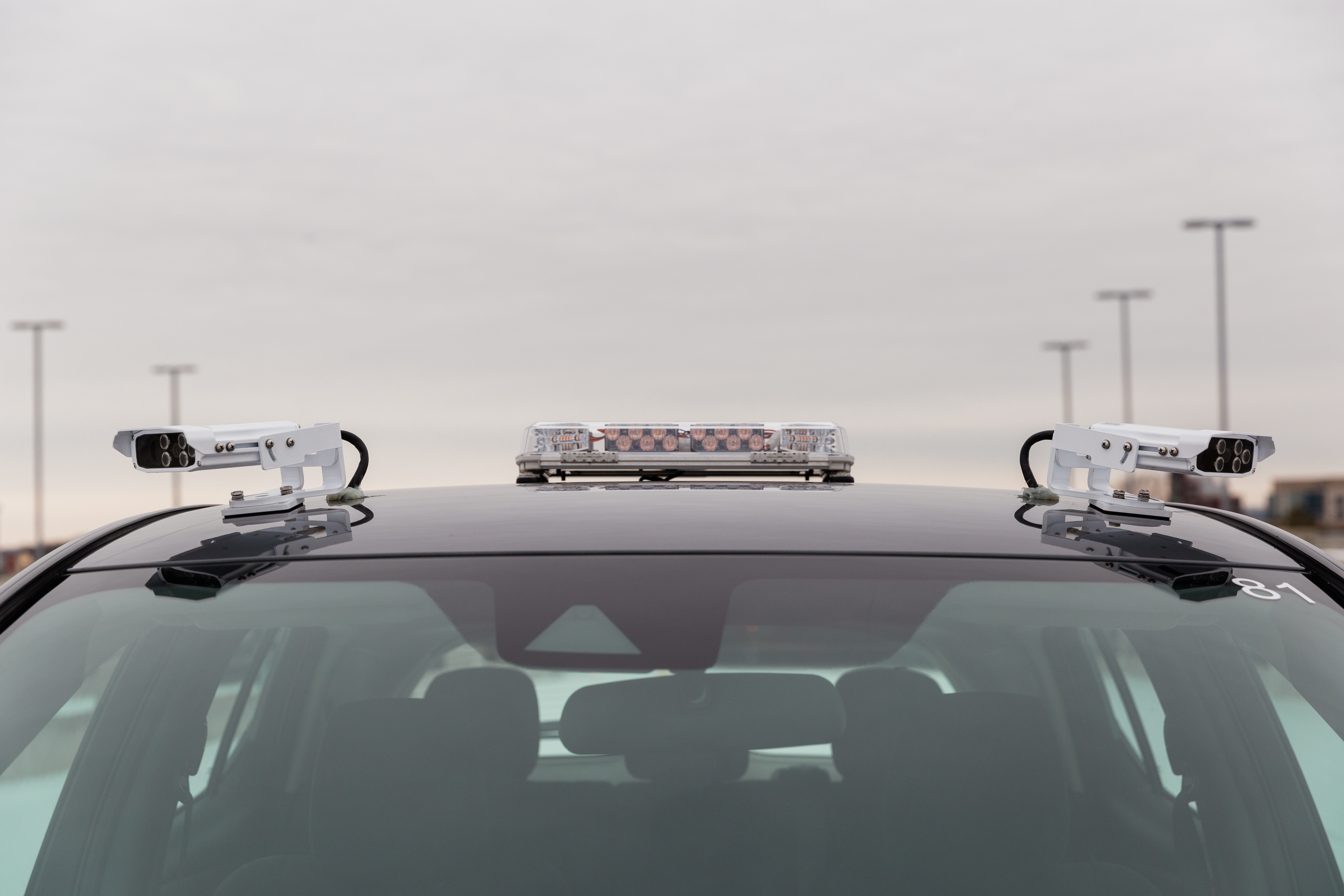IU Indianapolis Parking & Transportation Services continually searches for opportunities to enhance customer experience, create efficiencies, and adopt new solutions available in the industry. As part of our long-term strategic plan, a phased implementation of License Plate Recognition (LPR) technology began in the Spring of 2021
LPR Technology comes to IU Indianapolis
What is License Plate Recognition (LPR)?
License Plate Recognition (LPR) is a virtual permit system that allows you to use your license plate as your parking permit. No more worrying about properly displaying your parking permit or transferring your permit between vehicles. With LPR, your license plate is your virtual permit! However, for now, you must continue to display your permit until we have reached the final phase of implementation.
LPR is more than just replacing your parking permit. The readers affixed to Parking & Transportation Services vehicles, which can also be affixed to garages, can also count open parking spaces which will be displayed via a mobile App or other technologies in future phases. This will provide real-time parking options for visitors, students, and employees.
How does this work?
When a vehicle is parked on campus, the rear license plate is captured by readers mounted on Parking & Transportation Services vehicles. LPR works like a supermarket scanner with your license plate functioning as the barcode. When read, the numbers of your plate are automatically referenced against the parking database to verify proper parking privileges for the parking location.

When will this happen?
LPR program implementation is expected to progress through multiple phases over the next 3-5 years. Each phase will be measured and assessed to ensure the program provides a positive parking experience on campus and meets our goals. With each new phase, we will communicate information and make updates to this page.
After the successful completion of Phase 2 of LPR technology, Phase 3 of the program will begin on the IU Indianapolis campus in the Fall of 2025. You must continue to display your parking permit, and it is very important that you park so that your license plate faces the drive lane. This means no backing in or pulling through a parking space if your vehicle does not have a state-issued front license plate or you have purchased and affixed a campus-issued LPR plate to your front bumper. The campus-issued LPR plate can be purchased in the IU Indianapolis Parking & Transporation office for $14.50 each.
Phases
 | Phase 1:Test and evaluate LPR in surface lots and install readers in one garage to count open parking spaces. Evaluate the ability of LPR to recognize license plates. | Complete |
 | Phase 2:Test ability of LPR scanners to operate entry and exit gate arms. Install LPR readers at entry and exit of a student garage to pilot capabilities of LPR to recognize parking permissions associated with vehicle license plates when gates are up. Implement new rule and regulation requiring license plates to face drive lane.
| Complete |
 | Phase 3:Keep gates up in all student garages by using LPR to verify parking permissions. Move to virtual parking permits for students where their license plate will serve as their parking permit. | In Progress |
 | Phase 4:Install LPR readers at remaining garage entry and exits. Move to virtual permits for employees. | |
 | Phase 5:Final implementation may include: no physical hangtag permits for visitors or event attendees, removal of all garage entry and exit gates, pay-by-phone option in visitor garages and an App or other technologies announcing open parking spaces throughout campus. |
FAQs
We have developed the following FAQs in anticipation of some common questions related to LPR technology implementations. FAQs will be added or updated as we progress through phases of implementation.
As part of our mission, we are committed to customer-focused solutions that support the needs of our campus community. LPR provides a variety of benefits to campus parking operations. Benefits include:
Improved Customer Experience:
- Simplify/Streamline the permit renewal process – no extra trips to pick up permit, no waiting in line and no waiting for your permit to arrive in the mail
- No more:
- Visiting our office if you forget your permit
- Permits falling from rearview mirror or being improperly displayed
- Replacement fees for lost permits
- Remembering to switch your permit to another vehicle
- Scanning or swiping a permit when entering or exiting a garage. With LPR, it is automatic!
Locate Available Parking:
LPR can integrate with an App or other technologies to help you quickly and efficiently locate available parking.
Commitment to Sustainability:
The LPR initiative will use electric vehicles (EV), which have several environmental benefits compared to conventional internal combustion engine vehicles. EVs have lower operating and maintenance costs, produce little to no mobile air pollution, reduce dependence on petroleum, and reduce greenhouse gas emissions compared to fuel-powered vehicles. By eliminating parking permits, the University eliminates the production materials and waste from parking permit disposal at end of life.
Here are the three things you should do during Phase 2 of the LPR project implementation:
- Register your vehicle. All vehicles must be registered to your parking account with accurate license plate information. Unregistered vehicles will be subject to citation.
- Park with your license plate facing the drive lane. Because LPR technology only works if a license plate can be read by the LPR scanners, it is imperative that your license plate always face the drive lane. The only exceptions to this rule will be vehicles that already have a state-issued plate on the front of their vehicle or have affixed an IU campus-issued LPR plate to the front bumper. The LPR plate is available for purchase in our office for $14.50 if you prefer to pull through or back into spaces.
- Continue to display your valid parking permit. A valid parking permit must be displayed in your vehicle when parking on campus.
Log into your IU parking account to update your current vehicle information and license plate.
- Click the “Login” button located in the navigation bar in the upper right corner.
- Click the “IU or IU Health Login” button and enter your credentials.
- Click on the “Vehicles” button in the navigation bar at the top of the page.
- To edit a current vehicle, click on your “Plate Number”, click Edit and enter your new information.
- To add a new vehicle, click the “Add Vehicle” button
- To delete a vehicle, you must first add the new vehicle
- If you have a personalized plate with a special character (heart, star, hashtag, etc.) please skip the special character when entering the number into your online parking account. For example, if your plate reads “12#34”, you enter “1234”.
If you have any issues adding, updating, or deleting vehicles, please email us at JagsPark@iu.edu.
Yes. You may register up to five vehicles under your account; however, please remember that only one car may be parked on campus at a time with a permit or when LPR is implemented.
We recognize that this technology will have a learning curve for our community. Beginning in January 2023, we will place reminders on vehicles whose plates are not registered in the system with information on how to register that vehicle. Citations may begin later in 2023.
Readers must be able to read your license plate. However, we understand some habits are difficult to break. Beginning in January 2023, reminders will be placed on vehicles alerting you that your license plate is not facing the drive lane. Warnings and/or citations may be issued later in 2023.
As a reminder, vehicles with state-issued license plates or the IU campus-issued LPR plate affixed to the front bumper are exempt from this rule. LPR plates that can be mounted to your front bumper are available for purchase in our office located in the Vermont Street Garage at 1004 W. Vermont Street for a fee of $14.50. These plates will not expire and do not need to be renewed annually.
It is important your license plate and vehicle information is current and correct to avoid unnecessary citations. Please visit your IU Parking Account to update your information any time a change occurs. Remember to also delete old or unused vehicle listings from your account. You will need to enter your new vehicle first before deleting old ones. You may only have 5 vehicles registered to your account at any time.
Although a physical permit will no longer be required, there are other costs associated with managing an effective LPR system. As such, permit costs are not expected to change.
IU Parking Operations obtained all approvals required to proceed with this portion of the project. The LPR technology vendor went through the standard approval processes including a legal, policy and security review on privacy.
Any vehicle you drive to campus, whether it is your vehicle, one you borrow/share, or one you rent or have as a loaner must be registered to the parking account that purchased the permit. During Phase 2, please continue to display your physical permit in any vehicle you drive to campus.
Since the members of the carpool share permits and may drive separately, the members of the carpool should ensure that all carpool vehicles used to park on campus are listed on all the member parking accounts. In Phase 2, if you drive separately, each vehicle must display the carpool permit or one of the temporary permits. We are still determining the process for carpool members driving separately when we move to virtual permits. More information to come as we transition to later phases of the project.
The only information captured is a picture of your license plate. This information will not be shared with other departments or outside entities, unless required by law (such as a subpoena). All license plate photos are deleted after 120 days of capture unless they were taken as a result of your vehicle receiving a citation.
Open parking space counts from the LPR system can be communicated via an App or other technology for a better parking experience and used to maximize space in surface lots and garages to better serve the campus community.
LPR technology will recognize the first vehicle on campus as valid. Any additional vehicles on campus at the same time will be subject to a citation.
The visitor parking experience is not changing in this part of the LPR project. You should continue to direct your guests to park in visitor garages or metered kiosk spaces. If you have an event where you need to supply permits for guests to park in surface lots, continue to follow the same process.
Permit parking privileges will not change. IU Indianapolis campus parking privileges are available on the Intercampus Parking page. Please continue to display your parking permit while parking at IU Indianapolis.
Yes. However, since Purdue already implemented LPR, they no longer issue physical permits. Therefore, students and employees from Purdue should visit the Parking Office at Purdue first. Upon verification from their office, we will issue a physical permit parking at IU Indianapolis for the same time frame their permit is valid at Purdue. Changes to this process in future phases of LPR will be communicated.
Parking Operations cannot provide guidance on how an IU LPR plate will mount on every vehicle type. Your local dealership may be able to provide assistance. Please ensure you are familiar with the mounting options before purchasing the IU LPR plate, as they are non-refundable.
IU LPR plates must be mounted to the front of your vehicle, like your state issued rear plate. The IU LPR plate will be scanned by a vehicle mounted LPR camera calibrated to scan only in this area of the vehicle. The LPR cameras are not able to scan images such as the IU LPR plate in other locations of the vehicle.

